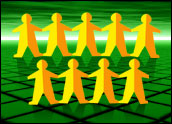
Welcome to the new frontier of Web 2.0.
Imagine sitting in your living room and pulling up a favorite TV show to watch online. Easily distracted — who isn’t these days — you simultaneously begin a chat with dear friends you’ve never met in person who live across the country. One tells you about a new gadget you decide you must have, and with a few clicks, you order it. You do all this from one device using multiple applications. You never once experience a crash.
“Sure, we talk about Web 2.0: the convergence of media, methodology and medium on the Internet,” said Lycos CEO Brian Kalinowski.
“It is more, though, than moving a type of file to where that files lives — such as moving an MP3 file to a P2P network. To me, Web 2.0 is about bringing together different media, like broadband film or text images, with different methodologies or applications,” he told the E-Commerce Times.
“It’s about taking the best of what MySpace does — but also using applications to augment those capabilities,” Kalinowski continued. “It’s about the convergence of consumption technology — cell phones, gaming systems and the Internet — to a point where you will have ubiquitous consumption across the Internet.”
That is Kalinowski’s vision — or version — of Web 2.0, and who’s to say whether he’s right or wrong? As it turns out, an informal query in the tech community about the definition of Web 2.0 yielded almost as many answers as respondents.
“The fact that different viewpoints on the issue take so many words to express suggests there is no clear consensus,” said David Gerken, founder and president of BuzzDash.com, which provides polls created by users.
“The industry has applied the term to encapsulate so many aspects of this evolving media — from the very specific, such as Ajax, to the very broad [such as] social networking, user-generated content — that it’s hard to define it more specifically than ‘a general notion of next-generation Internet technologies and service models,'” he told the E-Commerce Times.
The Authority
To be sure, there are formal definitions of the term. Given the subject matter, it is hardly inappropriate to turn to one of the star Web 2.0 players for help in this respect.
According to Wikipedia, Web 2.0 “refers to a perceived second-generation of Web-based services — such as social networking sites, wikis, communication tools, and folksonomie — that emphasize online collaboration and sharing among users. …
“Though the term suggests a new version of the Web,” the Wikipedia entry continues, “it does not refer to an update to Internet or World Wide Web technical standards, but to changes in the ways those standards are used. … Some technology experts … have questioned whether the term is meaningful, since many of the technology components of ‘Web 2.0’ have been present since the creation of the World Wide Web.”
A Community Focus
That definition is spot on (it is, after all Wikipedia), said many of the experts surveyed for this article, but most of them expanded on these themes.
Web 2.0 is all about the creation of community, Joe Lichtenberg, vice president of business development for software provider Eluma, told the E-Commerce Times.
“While Web 1.0 focused on siloed information, personal Web sites and downloading of MP3s, the new Web is positioned as a platform that invites collaboration, information-sharing and connections among users,” he explained.
“People today are looking for more than just information. They want connections, and Web 2.0 is enabling them to get what they want,” noted Lichtenberg.
“Personally, I like to think of Web 2.0 as the general movement from static, structured Internet services to dynamic, flexible, user- and/or community-involving services,” offered BuzzDash.com’s Gerken.
The advent of Web 2.0 helps to provide consumers with more choices, agreed Behzad Nadji, CEO of Frucall, a free, phone-based, price-comparison shopping service.
“Web 2.0 is the democratization of online content,” he told the E-Commerce Times. “It caters to the online consumer in an entirely new way. Now, users are empowered to make independent choices about the content they consume and how they consume it.”
User-Generated Editorial
The majority of respondents focused on the voice new Web 2.0 tools give to anyone who has an Internet connection.
It is not just user-generated content, but user-generated editorializing that makes Web 2.0 communities work, Dion Lin, president of Simply Hired, an employment Web platform used on many social networking sites, told the E-Commerce Times.
“Look at a Web site likeYelp, where people can point out if their reviews are good or not. That kind of personal self-expression is a big part of Web 2.0. You don’t necessarily want just anyone’s review of a movie — you want someone’s opinion that you trust,” he argued.
“The first decade of the Web was obsessed with the ‘technology-as-conduit’ mindset,” Jay Bailey, director of marketing for Answers Corporation, told the E-Commerce Times. “Suddenly we had instant communications, much like the fax machine had revolutionized written communication a decade before that. It simply sped up the transmission of the stuff we read.”
Web 2.0, by contrast, focuses on what’s being communicated, he said — and, more importantly, by whom.
“Sites and technologies labeled ‘Web 2.0’ — photo-sharing, RSS (really simple syndication), wikis, social networks — are all simply about ‘Everyman’ becoming part of a two-way global content exchange rather than the then-truly-revolutionary global Web 1.0 global content shop.”
Web 2.0, Part 2: Serious Business Tool or Silly Waste of Time?












































While a specific defintion of 2.0 might be difficult, the real underlying princinciples are community, speed and a focus on the user first. Some really interesting 2.0 sites popping up. Here are a couple lists: http://www.go2web20.net/ and http://www.netjaxer.com